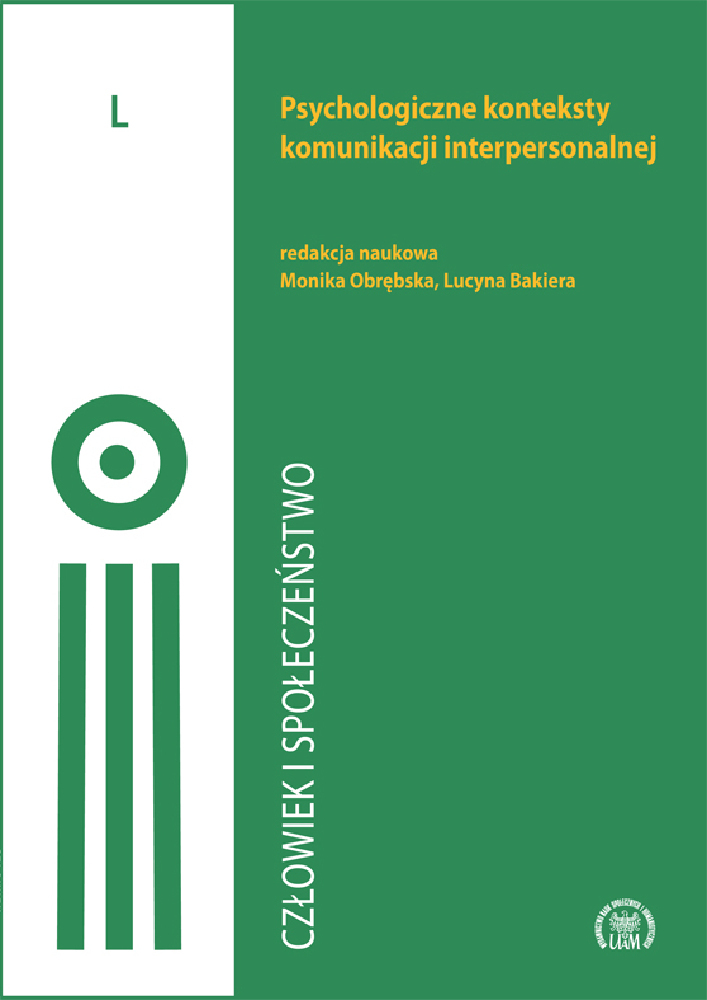Abstrakt
The main purpose of this study was to check whether there are relationships between the partner’s communication behaviours and online activity. The aspect of online activity was divided into: self-disclosure, support-seeking, making and keeping interpersonal contacts. To measure it, an authorial tool was used, called the Questionnaire of Activity in The Internet’s Social Space. In order to measure the partner’s communication behaviours, the Communication in Marriage Questionnaire (Kaźmierczak and Plopa) was used. It includes the following dimensions: support, commitment, depreciation. It was assumed that the partner’s depreciation will correlate positively, and both the partner’s support and commitment negatively with individual dimensions of online activity. The group of respondents consisted 85 women and 63 men, aged 19 to 71. The results showed that there is a positive correlation between partner’s depreciation and also a negative correlation between partner’s support and online supportseeking. No other hypotheses regarding the relationship between partner’s communication and online activity were confirmed. The correlation between the partner’s commitment and online self-disclosure turned out to be positive and therefore opposite to the assumption. Age was considered a variable that could have an impact on this unexpected result, as it negatively correlates with both the partner’s commitment and all dimensions of online activity.
Bibliografia
Bąk, A. (2016). Serwisy społecznościowe – efekt Facebooka i nie tylko. Media i Społeczeństwo, 6, 134–146.
Boyd, D., Ellison, N. (2008). Social network sites: Definition, history, and scholarship. Journal of Computer-Mediated Communication, 13, 210–230.
Celmer, Z. (1989). Małżeństwo. Warszawa: Państwowy Zakład Wydawnictw Lekarskich.
Doroszewicz, K. (2008). Bliskie związki a jakość życia. Psychologia Jakości Życia, 7(1, 2), 5–18.
Harwas-Napierała, B. (2008). Komunikacja interpersonalna w rodzinie. Poznań: Wydawnictwo Naukowe UAM.
Kardefelt-Winther, D. (2014). A conceptual and methodological critique of internet addiction research: Towards a model of compensatory internet use. Computers in Human Behavior, 31, 351–354.
Kaźmierczak, M., Plopa, M. (2012). Komunikacja w bliskich związkach. Teoria i metoda badania. Warszawa: Vizja Press & IT.
Krok, D. (2015). Satysfakcja ze związku małżeńskiego a poziom hedonistycznego i eudajmonistycznego dobrostanu psychicznego małżonków. Family Forum, 5, 141–160.
Krok, D., Murlowska, M. (2011). Komunikacja interpersonalna między małżonkami a poziom satysfakcji z małżeństwa. W: D. Krok, D. Klejnowski-Różycki (red.), Relacje rodzinne i społeczne w kulturze środkowoeuropejskiej i chińskiej (s. 126‒149). Opole: Redakcja Wydawnictw WT Uniwersytetu Opolskiego.
Liberska, H., Matuszewska, M. (2001). Wybrane psychologiczno-społeczne mechanizmy funkcjonowania małżeństwa. W: H. Liberska, M. Matuszewska (red.), Małżeństwo: męskość, kobiecość, miłość, konflikt (s. 13–28). Poznań: Wydawnictwo Fundacji Humaniora.
Melosik, Z. (2002). Kryzys męskości w kulturze współczesnej. Kraków: Oficyna Wydawnicza Impuls.
Plopa, M. (2005). Więzi w małżeństwie i rodzinie. Metody badań. Kraków: Oficyna Wydawnicza Impuls.
Pupin, Z., Waldmajer, J. (2013). Komunikacyjne zachowania w małżeństwie z perspektywy własnej i partnera. Family Forum, 3, 187–200.
Ryś, M. (2004). Jakość związku małżeńskiego a poziom bliskości małżonków i sposoby rozwiązywania przez nich konfliktów. Studia Psychologica, 5, 57–67.
Sanecka, E. (2014). Samoujawnianie online. Przegląd teorii i wyników wcześniejszych badań. W: K. Tucholska, M. Wysocka-Pleczyk (red.), Człowiek zalogowany 3 (s. 34–45). Kraków: Biblioteka Jagiellońska.
Varnali, K., Toker, A. (2015). Self-disclosure on social networking sites. Social Behavior and Personality, 43(1), 1–14.
Young, K.S. (1998). Internet addiction: The emergence of a new clinical disorder. CyberPsychology & Behavior, 1, 237–244.
Young, K.S., de Abreu, C.N. (2011). Closing thoughts and future implications. W: K.S. Young, C.N. de Abreu (red.), Internet Addiction: A Handbook and Guide to Evaluation and Treatment (s. 267–273). Hoboken, NJ: John Wiley & Sons.
Zając, J.M., Krejtz, K. (2007). Internet jako przedmiot i obszar badań psychologii społecznej. Psychologia Społeczna, 2, 3-4 (5), 191–200.
Zimbardo, P.G., Coulombe, N.S. (2015). Gdzie ci mężczyźni? Warszawa: Wydawnictwo Naukowe PWN.
Licencja
1. W momencie złożenia pracy celem rozpoczęcia postępowania w sprawie publikacji, Licencjodawca, zwany dalej Autorem, akceptuje wszystkie zasady umieszczone na stronie internetowej czasopisma “Człowiek i Społeczeństwo”, udzielając Licencjobiorcy, zwanego dalej Wydawcą, niewyłącznej i nieodpłatnej licencji na korzystanie z Utworu. Licencja zakłada tym samym brak ograniczeń terytorialnych, czasowych oraz ilościowych na następujących polach eksploatacji (art. 50 ustawy z dnia 4 lutego 1994 r. o prawie autorskim i prawach pokrewnych):
a. utrwalanie Utworu;
b. zwielokrotnienie Utworu drukiem i w wersji cyfrowej;
c. wprowadzenie do obrotu, użyczenie lub najem oryginału/zwielokrotnionych egzemplarzy Utworu;
d. publiczne wykonanie, wystawienie, wyświetlenie, odtworzenie oraz nadawanie i reemitowanie, a także publiczne udostępnianie Utworu w taki sposób, aby każdy mógł mieć do niego dostęp w miejscu i w czasie przez siebie wybranym;
e. włączenie Utworu w skład utworu zbiorowego;
f. wprowadzenie Utworu w postaci elektronicznej na platformy elektroniczne lub inne wprowadzenie Utworu w postaci elektronicznej do Internetu, Intranetu, Extranetu lub innej sieci;
g. rozpowszechnianie Utworu w wersji elektronicznej w Internecie, Intranecie, Extranecie lub innej sieci, w pracy zbiorowej, a także samodzielnie w formule Open Access w oparciu o licencję Creative Commons Uznanie autorstwa 4.0 Międzynarodowa Licencja Publiczna (CC BY 4.0), a także inną wersję językową tej licencji, lub którąkolwiek późniejszą wersję tej licencji.
2. Założenia licencji Creative Commons Uznanie autorstwa 4.0 Międzynarodowa Licencja Publiczna (CC BY 4.0), udzielają Wydawcy upoważnienia do kopiowania, zmieniania, rozprowadzania, przedstawiania i wykonywania Utworu jedynie pod warunkiem uznania autorstwa.
3. Wraz z dostarczeniem Utworu, Autor zobowiązuje się do wypełnienia, podpisania oraz odesłania skanu umowy

